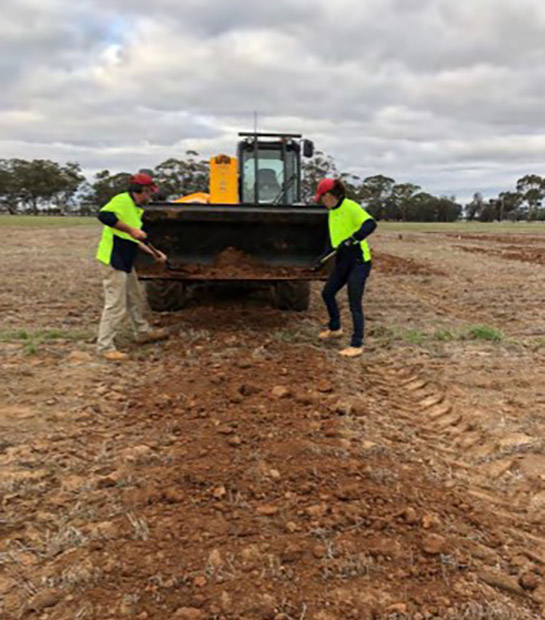BIRCHIP CROPPING GROUP
This fact sheet supports the ‘Deep ripping, claying and manuring on sandy soils in the Wimmera’ webinar hosted by Soil CRC Community of Practice participant Kate Maddern, Birchip Cropping Group (BCG).
The webinar covered:
- soil carbon
- Lubeck and Netherby trials
- key learnings
- considerations for deep ripping, claying or manuring.
Soil carbon
Soil carbon is essential for crop growth and is derived from plant biomass that remains in the soil after harvest. Soil organic matter, which includes carbon, contains vital nutrients for crops.
Lubeck trial
In the Lubeck trial (30 km east of Horsham. Victoria), low water holding capacity and compacted sand were key constraints to growing biomass. Soil amendments included chicken manure (organic matter and nutrients), a fertiliser blend (plant nutrients), and deep ripping (mechanically breaking the compaction) to improve soil structure and amend the constraints for improved plant productivity.
Establishment challenges in the trial were caused by rain-induced furrow slumping, which affected seed depth and emergence. Nutrient application methods were impacted by soil disturbance during sowing.
The chicken manure application resulted in increased yields and grain protein due to the extra nutrients.
Netherby trial
The Netherby trial (100 km north west of Horsham, Victoria), located in a drier area with shallower sandy soil and clay pans, faces challenges like limited root depth and low water holding capacity. This trial started in 2020, focusing on improving soil conditions for better crop growth.
Considerations
Understanding the specific constraint in your soil is crucial. Soil testing and soil profile assessment is crucial to understand soil type and nutrient levels before implementing soil amelioration techniques. Identify problems such as compaction layers, water-holding capacity, nutrient deficiencies, pH issues, salinity, root diseases, and herbicide residues.
Choosing the right crop type and sowing depth is essential for successful establishment. Timing of soil amelioration treatments should be carefully considered to minimise erosion and optimise crop establishment. Consider the risk of herbicide residues and weed levels when planning soil amelioration treatments.
When considering soil amelioration techniques, start small with trial patches or strips before applying them to the entire paddock. Test the effectiveness, machinery setup, and potential issues. Take a targeted approach to problem areas rather than treating the entire field.

Spreading clay (Source: BCG)
Related Soil CRC project resources
- Project fact sheet: Mapping projects on ameliorating soil constraints, and review of soil constraints, products and technologies
- Project presentation: Amelioration of subsoil constraints using innovative products and precision placement of soil amendments
- Project presentation: Sandy soils: Organic and clay amendments to improve the productivity of sandy soils
- Project video: Soil organic amendment trial – Badgingarra, Western Australia
- Project presentation: New amendments for sandy soils
- Project overview: Capitalising on established field trials for ameliorating (sub)soil constraints
- Project news story: Collaboration delivers new sandy soils map
Further information
Acknowledgement
This fact sheet was published as part of the ‘Building technical capacity for improved soil management’ project. It was produced by the Soil CRC and jointly funded through the Australian Government’s National Landcare Program.
Posted Apr 18, 2024

